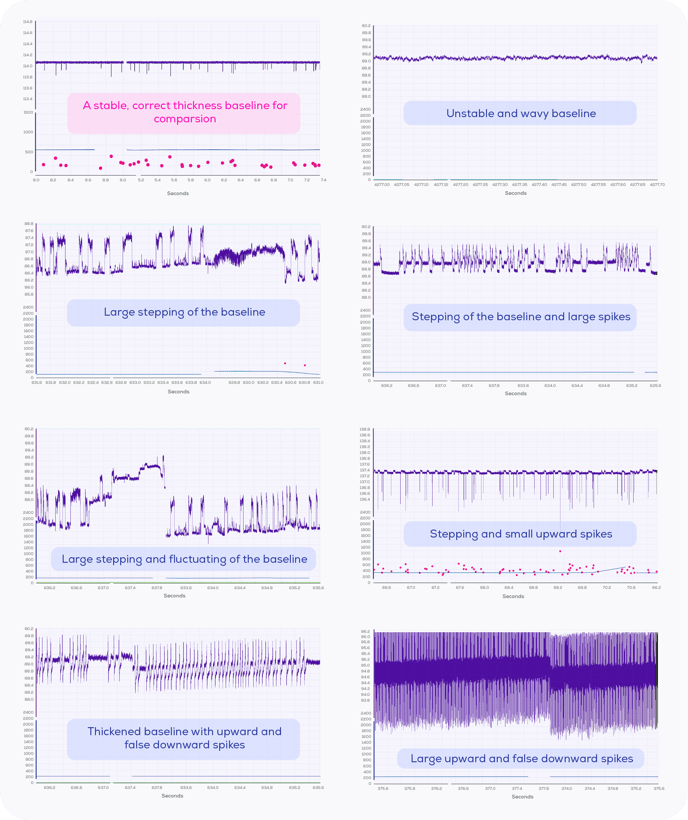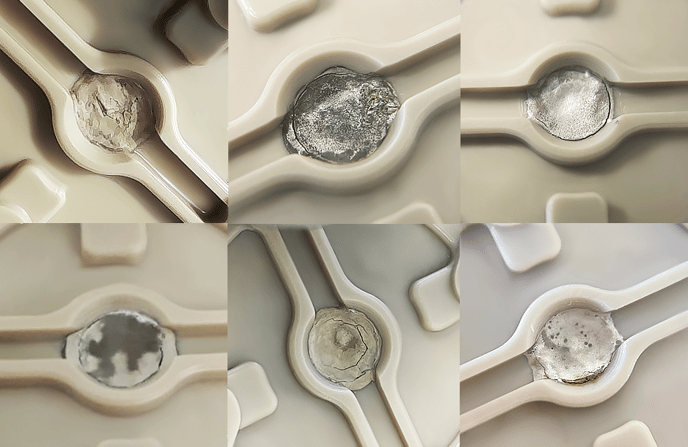Identifying issues with the lower fluid cell
The lower fluid cell of the Exoid contains a conductive silver chloride paste which covers the lower electrode. The silver chloride paste is integral to maintaining stability. As such, when a paste issue arises, it can present as a nanopore issue.
What are the symptoms of lower fluid cell paste issues?
There could be damage to the silver chloride paste in the lower fluid cell if you experience any of the following issues:
- An unstable baseline, often with higher RMS noise than expected or one which drifts (e.g., rises).
RMS (root mean square) is a real-time measure of the background electrical noise of the system. A stable baseline current is one that is 100-140 nA, drifts by less than 0.5 nA in 60 seconds and has an RMS noise of <15 pA. An unstable baseline current will produce unreliable measurements and should not be used under any circumstances.
- Thickening of the baseline
- Upward spines in the baseline in addition to regular downward spikes
- The current offset is not as expected, for example:
- The current not resting at 0 ± 3 nA when the voltage is at 0 V
- The current being different when applying identical positive or negative voltage
- Flakes of paste visible in the fluid present in the lower fluid cell
Figure 1 shows what some of these symptoms look like.

Figure 1. Patterns in the baseline current indicative of lower fluid cell paste issues.
What do issues with the lower fluid cell paste look like?
At this point, it is wise to visually inspect the lower fluid cell paste. Issues with lower fluid cell paste issues are shown in Figure 2, with 'healthy' fluid cell paste in Figure 3. Discolouration or oxidisation is not necessarily an issue.

Figure 2. Examples of cracks, holes and the paste lifting off the lower fluid cell. Top left image shows flaking and holes. Top middle and top right both show cracking around the outside of the paste. Bottom left shows cracking around the outside of the paste, plus discolouration. Bottom middle shows cracking. Bottom right shows cracking around the outside and lifting off the lower fluid cell.

Figure 3. Depictions of undamaged lower fluid cell paste. Note the middle image shows a 'lump' which, whilst this may look abnormal, does not impact the functioning of the fluid cell.
What should you do if you suspect damage to the lower fluid cell paste?
If you visually see or otherwise suspect that the paste in the lower fluid cell is damaged, then please fill in the support request form. Support will then contact you to arrange for your lower fluid cell to be inspected and, if necessary, for the lower fluid cell to be re-pasted.
What should you do if you are experiencing the symptoms of lower fluid cell paste damage but do not see visual signs of damage?
Begin by removing the upper fluid cell and ensuring that there is no liquid on top of the nanopore. If there is, remove this. You can also remove the nanopore and dry and clean the lower fluid cell. Replace the nanopore and the upper fluid cell, replace the electrolyte and re-establish current. If this does not fix the issue, please record a 3 minute measurement and take a photo of the lower fluid cell paste and send both to support.